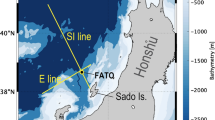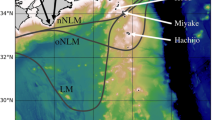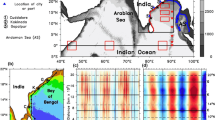Abstract
The surface layers of the Bay of Bengal along the east coast of India exhibit intricate stratification owing to the differential distribution of freshwaters. The winter (January–February) cooling of the salinity-induced stable layers results in the development of thermal inversions that deteriorate toward the end of the season. The study focuses on the behavior of the thermal inversions in the light of the variable stratification and the monsoon imposed reversing coastal current. To address the associated processes, a three-dimensional Princeton Ocean Model is applied for the east coast of India, and numerical experiments carried out to study the means by which the thermal inversions tend to perish with the passage of winter. The model domain with variable curvilinear grid uses input fields that comprise realistic bathymetry and initial temperature/salinity conforming to winter/specified stratification. The surface forcing comprises wind stress and diurnal pattern air–sea heat fluxes. The body forcing is derived from the periodic tidal elevations at the open boundaries. It has been found that the thermal inversions tend to sustain as the equator-ward flowing East India Coastal Current (EICC) traps the cool low saline waters between Paradip and Kakinada. The current off Paradip is weak and variable and is not a part of EICC. Consequently, in the absence of replenishment of cool and freshsurface waters, the temperature/salinity gradients get eroded steadily. No thermal inversions are noticed south of Kakinada because of relatively weak current with diminished vertical salinity gradient. As the nature of stratification encountered in the bay is highly variable due to diverse reasons, the behavior of internal waves under different stratification scenarios is also addressed. Numerical experiments indicate that the energy/amplitude of the internal waves are comparable in the surface layers for any stratification, where as it is certain orders exalted in the deeper waters of the strong stratification scenario. Further, it is found that the energies and pattern of the temperature oscillations conform to the nature of mixed tide at the corresponding latitude. The underneath stratification is found to be more responsible for the generation of internal waves compared to the local stratification. This implies that the body forcing emanating from below is the cardinal contributor for the generation of internal waves. The numerical experiment with a flat and uniform bottom showing weak manifestation of internal waves endorses the same. This connotes that the continental slopes are an effective generator of the internal waves and the energy flux conversion of the barotropic tide to internal waves seems to be heavily dependent on the shoaling bottom.














Similar content being viewed by others
References
Antony MK, Murty CS, Reddy GV (1985) Sub-surface temperature oscillations and associated flows in the western Bay of Bengal, Estuarine. Coast Shelf Sci 21:823–834
Babu SV, Rao AD, Mahapatra DK (2008) Pre-monsoon variability of ocean processes along the east coast of India. J Coastal Res 24:628–639
Baines PG (1982) On internal tide generation models. Deep Sea Res Part A 29:307–338
Blumberg AF, Mellor GL (1987) A description of a three dimensional coastal ocean circulation model in three-dimensional coastal ocean models. AGU, Washington, DC
Boyer T, Levitus S, Garcia H, Locarnini RA, Stephens C, Antonov J (2005) Objective analyses of annual, seasonal and monthly temperature and salinity for the world ocean on a 0.25 grid. Int J Climatol 25:931–945
Craig PD (1988) A numerical model study of internal tides on the Austrailian North West Shelf. J Mar Res 46:59–76
Ezer T, Mellor GL (1994) Diagnostic and prognostic calculations of the North Atlantic circulation and sea level using a sigma coordinate ocean model. J Geophys Res 99(C7):14159–14171
Garret CJR, Munk WH (1972) Space time scales of internal waves. Geophys Fluid Dynamics 3:225–264
Garret CJR, Munk WH (1975) Space time scales of internal waves. A progress report. J Geophys Res 80:291–297
Garret CJR, Munk WH (1979) Internal waves in the ocean. Annu Rev Fluid Mech 11:339–369
Haney RL (1991) On the pressure gradient force over steep topography in sigma coordinate ocean models. J Phys Oceanogr 21:610–619
Holloway PE (2001) A regional model of the semidiurnal internal tide on the Australian North West Shelf. J Geophys Res 106:19625–19638
Holloway PE, Merrifield M (1999) Internal tide generation by seamounts ridges and Islands. J Geophys Res 104:25937–25951
Kanarska Y, Maderich V (2003) A non-hydrostatic numerical model for calculating free-surface stratified flows. Ocean Dyn 53:176–185
LaFond EC (1962) Internal waves. In: Hill MN (ed) The sea, vol 1. Wiley, New york, pp 731–751
LaFond KG, Rao CP (1954) Vertical oscillations of tidal periods in the temperature structure of the sea. Andhra Univ Memoris 1:109–116
Mellor GL (1992) User’s guide for a three-dimensional, primitive equation, numerical ocean model, report, 35 pp., program in atmospheric and oceanic sciences. Princeton University, Princeton
Mellor GL, Yamada T (1982) Development of a turbulence closure model for geophysical fluid problems. Rev Geophys 20:851–875
Pankajakshan T, Gopalakrishna VV, Muraleedharan PM, Reddy GV, Araligidad N, Shenoy S (2002) Surface layer temperature inversion in the Bay of Bengal. Deep Sea Res Part I 49:1801–1818
Rao AD, Babu SV, Prasad KVSR, Ramana Murty TV, Sadhuram Y, Mahapatra DK (2010) Investigation of the generation and propagation of low frequency internal waves: a case study for the east coast of India. Estuar Coast Shelf Sci 88:143–152
Rattray M (1960) On the coastal generation of internal tides. Tellus 22:54–62
Shen H, He Yi-Jun (2005) Study of internal waves in North West of South China Sea by satellite images. In: Proceedings of geoscience and remote sensing symposium, vol 4. Institute of Electrical and Electronics Engineers, pp 2539–2542
Sherwin TJ, Taylor NK (1990) Numerical investigations of linear internal tide generation in the Rockall trough. Deep Sea Res 10:1595–1618
Sindhu I, Suresh I, Unnikrishnan AS, Bhatkar NV, Neetu S, Michael GS (2007) Improved bathymetric data sets for the shallow water regions in the Indian Ocean. J Earth Syst Sci 116:261–274
Wadzuk BM, Hodges BR (2004) Hydrostatic and non-hydrostatic internal wave models, final report to the office of naval research under contract No. N00014-01-1-0574, CRWR online report 04–09
Acknowledgments
We sincerely thank the Naval Research Board (India) for providing the financial support during the course of the study. Thanks are also due to Dr. D. Srinivasan, former director of NPOL for his useful comments and suggestions in bringing out this article.
Author information
Authors and Affiliations
Corresponding author
Appendix
Appendix
An overview of the relative importance/contribution of the boundary/body forcing is addressed here. Numerical experiments are carried out considering only tidal forcing (no heat flux) and only surface heat fluxes (no tide) with common wind stress forcing in the strong stratification scenario. Figure 15 depict the spectral estimates at 5 and 20 m depth, respectively, for the tide only experiment. The energy in the semidiurnal range (0.08 cph ≈ 12.5 h) at 5 m depth is weak, which has increased substantially at 20 m. There is no energy in the diurnal range (0.04 cph ≈ 24.0 h) associated with tidal forcing and the semidiurnal energy substantially increased with depth. Figure 16 depict the spectral estimates at 5 and 20 m depth, respectively, for the flux only experiment. Here also the energy in the semidiurnal range (0.08 cph ≈ 12.5 h) at 5 m depth is weak but unlike the tide only scenario, the crux of the energy here is in diurnal range (0.04 cph ≈ 24 h). The scenario at 20 m depth is again different. The semidiurnal component is missing all together and the diurnal one has substantially dropped. From these experiments, we may conclude that the influence of the surface heat fluxes are attenuated and weaken sharply with depth while on the contrary, the body forcing assumes strength with depth. As the internal wave activity is essentially in the deeper waters (below the mixed layer), we may conclude that the principal contributor to the generation of internal waves is only the tidal forcing.
Energy spectra of temperature oscillations only with flux (no tide) at the same depths as in Fig. 15
Rights and permissions
About this article
Cite this article
Rao, A.D., Babu, S.V., Murty, P.L.N. et al. Impact of stratification on internal waves and differential wearing of thermal inversions on the east coast of India. Nat Hazards 57, 577–595 (2011). https://doi.org/10.1007/s11069-010-9616-4
Received:
Accepted:
Published:
Issue Date:
DOI: https://doi.org/10.1007/s11069-010-9616-4






